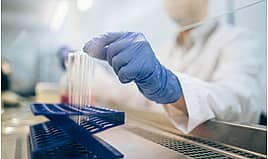
Biological Safety Cabinets (BSCs) serve two main purposes: protecting employees from the biological material being handled and preventing contamination of the work being conducted. However, improper use of BSCs can result in a decreased ability of the cabinets to provide personnel protection and prevent contamination. With proper planning and by following appropriate work practices, BSC performance can be maximized to protect the researcher and their work.
Before Working in the BSC
- Some BSCs are designed to run 24/7; however, for those that are designed to be shut off, they should be turned on at least 10 minutes before starting work. This allows the cabinet blowers to remove contaminated air and particulates from the cabinet.
- The work surface, back, and sidewalls, and back of the sash should be decontaminated with an appropriate disinfectant (e.g., 70% ethanol) to minimize or eliminate surface contamination. All items required to be placed into the cabinet should also be surface decontaminated to reduce the introduction of contaminants into the BSC.
- The workflow should be set up from clean to dirty with the work area in the middle; this set-up will limit the movement of dirty items over clean ones. This can be done by placing clean items on one side (generally the left for right-handers and the right for left-handers) and transferring them to the other side as they become used/dirty/contaminated to reduce cross-contamination.
- Whenever possible, all materials needed for a procedure should be placed inside the BSC before starting work. Larger items such as pipette trays and boxes should be kept towards the back and side of the cabinet. Aerosol generating equipment should also be placed towards the back of the cabinet without blocking the exhaust grills.
Working in the BSC
- Personal protective equipment should be worn not only to protect the researcher but also to avoid introducing contamination from their skin. Gloves should be disinfected or replaced whenever they touch a non-sterile surface outside the BSC.
- Work should be conducted towards the middle of the cabinet and at least 4 inches from the front grill. Nothing should be placed on the grill at the front opening of the cabinet and the grill at the back of the cabinet should not be blocked. Excess items blocking the grills may cause disruption of airflow, resulting in turbulence and possible cross-contamination; extra supplies should be stored outside the BSC.
- To reduce the chance for cross-contamination of materials, tubes and bottles should be opened by holding them in a reclined position, not vertically, and they should be recapped or covered as soon as possible. A lid or cover should be held above petri dishes and plates to minimize the impact of downward air.
- Movement of arms into and out of the BSC can disrupt airflow, negatively affecting cabinet performance. Arms should be moved slowly and straight out of the BSC, perpendicular to the face of the cabinet. Researchers should not block the front grille by resting their arms on it.
After working in the BSC
- Items should be surface-disinfected before removal from the BSC as droplets or aerosols generated during operations in the cabinet might have contaminated them.
- Cabinet surfaces should be disinfected with an appropriate disinfectant. More in-depth cleanings should be conducted periodically that include removing the work surface and disinfecting the area beneath it, including the drain pan/catch basin.
- The blower fan should be allowed to run for 5 to 10 minutes after finishing work to purge the cabinet before turning off the blower (note that some BSCs are designed to be left on at all times, so manufacturer recommendations should be followed for each BSC type).
Other Reminders
- Open flames should not be used in a BSC as they create turbulence that disrupts the pattern of HEPA-filtered air being supplied to the work surface. This disruption can lead to contamination of samples and potential release of contaminants from the cabinet.
- Per the CDC and the NIH, UV lamps are not recommended for BSC disinfection as the activity of UV lights is limited by a number of factors. These include: microorganisms beneath dust particles or beneath the work surface are not affected by the UV irradiation; dust and dirt can block the germicidal effectiveness of UV lights, and the effectiveness of the UV light decreases with age.
For more information on proper BSC use, or for assistance with training your lab staff on proper BSC work practices, please email [email protected].
This blog was written by Beth Graham, our Associate Director of Quality, Research, and Training who has been with Safety Partners for the last 11 years.
